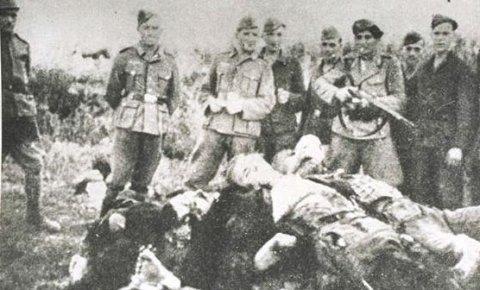 WW2 History of Europe
ww2 history
WW2 History of Europe
ww2 history
Yugoslavian massacre, Blagaj
On April 28, 1941, Units of the Croatian Ustashi Army, a militia created by the Croat Prime Minister, Ante Pavelic, surrounded the villages of Gudovac and Brezovica and killed 234 inhabitants who held Serbian nationality. They were told to go home to Serbia or convert to Roman Catholicism, refusal to do so ended in death. In the village of Blagaj, 520 men, women and children, were murdered in the most cruel way by being hit over the head.
In the Koprivnica Forest near Livno, around 300 souls were subjected to the most unspeakable acts of brutality before being killed. Hands and legs were cut off, eyes gouged out, heads of small children were severed and thrown onto their mothers laps, breasts were severed and children's hands pulled through and tied together. In the Livno area alone, the Ustashi killed 1,243 Serbs including 370 children.
In the Risova Greda Forest, over 800 Serbs were killed and their bodies hurled into ravines. On July 10 in the town of Glina, around 700 Serbs were gathered in the local Serbian Orthodux church, ostensibly for conversion to Catholicism. Locked inside the church, all were beaten with wooden mallets, clubs, rifle butts and stabbed with bayonets and knives before being left to die as the church was set on fire and burned to the ground.
The Ustashi commander, General Dragutin Rumler, filed a report stating that so far, around 10,000 Serbs, Jews and Gyspies had been killed to date. The German occupation forces at that time turned a blind eye to the slaughter, after all, the Ustashi were doing what the Nazi Gestapo and S.D. units had come here to do. By far the worst crime committed by the Ustashi was the murder of children from the Mount Kozara region.
The Serb children were separated from their parents and taken to various interment camps set up by the Ustashi. In the camp at Sisak, 6,693 children were housed in filthy conditions and soon 1,600 died. At the camp at Jastrebarko, 3,336 children were housed in the same pitiful condition. Soon after their arrival the local cemetery caretaker had buried 768 boys and girls. In Plot 142 in the Mirogoj Cemetery in Zagreb lie the remains of 862 children who had died after being rescued by the Red Cross.
Hundreds of families in Zagreb adopted 938 of these children without even knowing their names or identity. Fifty years after this tragedy, a final count was made. The crimes committed by the Ustashi troops in 1941 and 1942 took the lives of 11,176 children (6,302 boys and 4,874 girls) The average age of these children was 6.5 years.
This crime of Genocide, committed by the pro-German Catholic Croatians on the Orthodox Serbian population during World War Two is something the outside world knows little about. (On December 12, 1941, the Independent State of Croatia declared war on the United States following the Japanese attack on Pearl Harbor) Ante Pavelic, fugitive war criminal, escaped the slaughter of Bleiburg only to surface several years later in Argentina.
After an attempt on his life in April, 1957, Pavelic moved lock, stock and barrel to the safety of fascist Spain. There, on December 28, 1959, he died from complications relating to injuries received during the assassination attempt.
